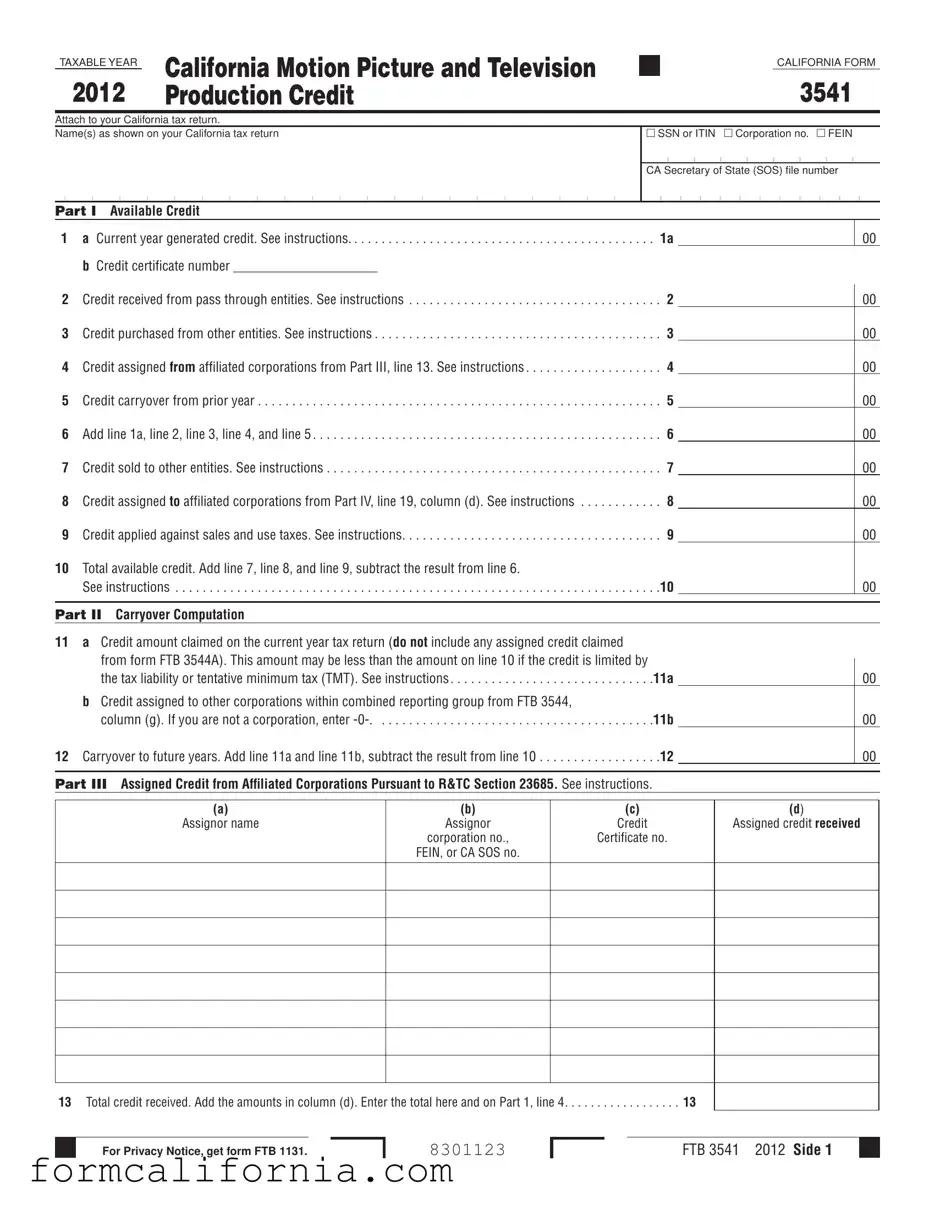Important Information
California Motion Picture and Television Production Credit. For taxable years beginning on or after January 1, 2011, Revenue & Taxation Code (R&TC) Section 17053.85 and Section 23685 allow a qualified taxpayer a California motion picture and television production credit against the net tax (individuals) or tax (corporations) and/or qualified sales and use tax. The credit, which is allocated and certified by the California Film Commission (CFC), is 20% of expenditures attributable to a qualified motion picture or 25% of production expenditures attributable to an independent film or a television series that relocates to California.
Write “CFC Credit”– Taxpayers attaching form FTB 3541, California Motion Picture and Television Production Credit, to the tax return should write “CFC Credit” in red ink at the top margin of their tax return.
Use of Credit – The credit can be used by the qualified taxpayer to:
•Offset franchise or income tax liability. Use credit code number 223 when claiming this credit.
•Sell to an unrelated party (independent films only).
•Assign to an affiliated corporation.
•Apply against qualified sales and use taxes.
This credit is not refundable.
Sales and Use Taxes – A qualified taxpayer who has been issued a certified Form M, Tax Credit Certificate, from the CFC may make an irrevocable election with the Board of Equalization (BOE) to apply the credit against qualified sales and use taxes. For more information, go to boe.ca.gov and search for ca film.
Credit Assignment – A qualified taxpayer that is a corporation or is taxed as a corporation and whose credit exceeds the tax may elect to assign the credit to an affiliated corporation(s). The election to assign the credit is irrevocable. For more information, see General Information C, Credit Assignment.
Sale of Credit Attributable to an Independent Film – A qualified taxpayer may sell a credit, attributable to an independent film, to an unrelated party once the taxpayer receives Form M from the CFC. The credit can only be sold by the qualified taxpayer that generated the credit (that is a corporation, a Limited liability company (LLC) or partnership taxed as a corporation, or an individual) or by a shareholder, beneficiary, partner, or member who received the credit as their distributive or pro-rata share. For more information, get form FTB 3551, Sale of Credit Attributable to an Independent Film, or go to ftb.ca.gov and search for motion picture.
Seller – A qualified taxpayer that sells an independent film credit is required to report the gain on the sale of the credit in the amount of the sale price.
Buyer – If the credit was purchased for less than the credit amount stated on Form M, the buyer is required to report income in the amount of the difference between the credit amount claimed on its return and the purchase price.
General Information
A Purpose
Use form FTB 3541 to report the credit for the production of a qualified motion picture in California that was:
•Allocated from the CFC on Form M, Tax Credit Certificate.
•Passed through from S corporations, estates and trusts, partnerships, or limited liability companies (LLCs) taxed as partnerships.
•Purchased from a qualified taxpayer.
•Assigned to or from an affiliated corporation under R&TC Section 23865(c)(1). For more information, see General Information C, Credit Assignment.
•Applied or will be applied against BOE qualified sales and use taxes. For more information, go to boe.ca.gov and search for ca film.
Note: Each entity that received or assigned a motion picture and television production credit from or to another entity within a combined reporting group must complete a separate form FTB 3541.
S corporations, estates and trusts, and partnerships, or LLCs taxed as partnerships should complete form FTB 3541 to figure the amount of credit to pass-through to shareholders, beneficiaries, partners, or members. The credit is not allowed at the pass-through entity level. Attach this form to Form 100S, California S Corporation Franchise or Income Tax Return; Form 541, California Fiduciary Income Tax Return; Form 565, Partnership Return of Income; or Form 568, Limited Liability Company Return of Income. Show the pass-through credit for each shareholder, beneficiary, partner, or member on Schedules K-1 (100S, 541, 565, or 568), Share of Income, Deductions, Credits, etc.
Corporate taxpayers attach this form to Form 100, California Corporation Franchise or Income Tax Return, or Form 100W, California Corporation Franchise or Income Tax Return - Water’s Edge Filers.
Individual taxpayers attach this form to Form 540, California Resident Income Tax Return, or Form 540NR, California Nonresident or Part-Year Resident Income Tax Return.
B Definitions
Credit certificate. Credit certificate means the certificate issued by the CFC for the allocation of the credit to a qualified taxpayer.
Qualified taxpayer. Qualified taxpayer means a taxpayer who has paid or incurred qualified expenditures and has been issued a credit certificate by the CFC. In the case of any pass-through entity, the determination of whether a taxpayer is a qualified taxpayer is made at the entity level. The credit is not allowed at the pass-through entity level. The credit is passed through to the shareholders, beneficiaries, partners, or members.
Qualified motion picture. Qualified motion picture means a motion picture that is produced for distribution to the general public, regardless of medium. For more information, refer to the R&TC Section 17053.85, Section 23685, or go to film.ca.gov.
Independent film. Independent film means a motion picture with a minimum budget of one million dollars ($1,000,000) and a maximum budget of ten million dollars ($10,000,000) that is produced by a company that is not publicly traded and publicly traded companies do not own, directly or indirectly, more than 25 percent of the producing company.
Television series. Television series means a television series that relocated to California, without regard to episode length or initial media exhibition, that filmed all of its prior season or seasons outside of California and for which the taxpayer certifies that this credit is the primary reason for relocating to California.
Affiliated corporation. Affiliated corporation has the meaning provided in R&TC Section 25110(b), except that “100 percent” is substituted for “more than 50 percent” wherever it appears in the section and “voting common stock” is substituted for “voting stock” wherever it appears in the section. For more information, see General Information C, Credit Assignment.





